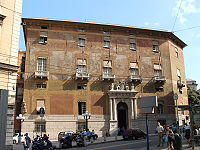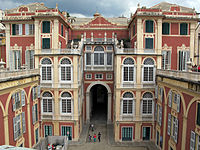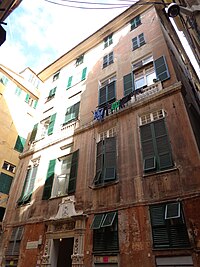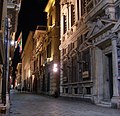Palazzi Dei Rolli
- The Strade Nuove (Italian for "New Streets") are a group of streets built by the Genoese aristocracy during the expansion of the city at a time when the Republic of Genoa was at the height of its financial and seafaring power. These are Via Giuseppe Garibaldi (1558-1583, formerly Strada Maggiore or Strada Nuova) and Via Balbi (1602-1620, formerly Strada Balbi), later followed by Via Cairoli (1778-1786, formerly Strada Nuovissima).
- The Palazzi dei Rolli (Italian for "Palaces of the Lists") are a group of palaces - most of which also date from the late 16th and early 17th centuries - which were associated to a particular system of ‘public lodging’ in private residences, whereby notable guests on State visit to the Republic were hosted in one of these palaces on behalf of the State.
On 13 July 13, 2006, forty-two of the 163 palaces originally included in one the five public list called "Rolli" (Italian for "lists") were selected as a World Heritage Site by the UNESCO special committee meeting in Vilnius (Lithuania). The site includes an ensemble of Renaissance and Baroque palaces along the so-called ‘new streets’ (Strade Nuove), which offer an extraordinary variety of different solutions, achieving universal value in adapting to the particular characteristics of the site and to the requirements of a specific social and economic organization. They also offer an original example of a public network of private residences designated to host state visits.

On January 20, 2007, UNESCO unveiled a plaque in via Garibaldi, the former Strada Nuova, explaining the reasons for inclusion of the Strade Nuove and the system of the Palazzi dei Rolli within the World Heritage Sites:
The largest homes, various in shape and distribution, that were chosen at random in the lists (rolli) to host visits of state. The buildings, often built on sloping land, formed of a stepped atrium - courtyard - staircase - garden and rich interior decorations, express a singular social and economic identity and commencement of modern age urban architecture in Europe.
Some of the Palazzi dei Rolli are used today as public buildings, museums, offices and private residences. Among the palaces open to the public, Palazzo Rosso, Palazzo Bianco and Palazzo Doria Tursi jointly constitute the Strada Nuova Museums located in via Garibaldi.
The Rolli of Genoa
The Rolli di Genova—more precisely, the Rolli degli alloggiamenti pubblici di Genova (Italian for "Lists of the public lodgings of Genoa") were the official lists at the time of the Republic of Genoa of the private palaces and mansions, belonging to the most distinguished Genoese families, which—if chosen through a public lottery—were obliged to host on behalf of the Government the most notable visitors during their State visit to the Republic.
Later, these palaces hosted many famous visitors to Genoa during their Grand Tour, a cultural itinerary around Italy.
Today, Palazzi dei Rolli as a collective name represents the set of the most prestigious palaces of the historical center of Genoa, especially along the so-called Strade Nuove, the "New Streets" built by the Genoese aristocracy at the peak of Genoa's economic power in the 16th and 17th century (Via Giuseppe Garibaldi, formerly Strada Nuova or Via Aurea, Via Cairoli, formerly Strada Nuovissima, and via Balbi, now the home of the University of Genoa).

History
Between the first half of the 16th century and the first half of the 17th century, the Genoese nobility started a careful town planning to transform the existing medieval city and initiate a sizeable urban expansion to the North. The move to expand the antique palaces and to build new sumptuous ones was driven by the extraordinary wealth that came into the city through prosperous financing activities towards several European powers. In particular, the Genoese aristocracy financed the expensive undertakings of the Spanish Crown, such as the mercenary army that Spain kept in Flanders from 1566 to the peace of Westphalia in 1648. The ruling class of Genoa, mixing nobility of blood with new mercantile wealth, sought to underpin their prestige by the construction of grand city palaces and suburban villas of unusual splendor.
The Rolli—more precisely, the Rolli degli alloggiamenti pubblici di Genova (Italian for "Lists of the public lodgings of Genoa")—were official lists established in 1576 by the Genoese Senate—an aristocratic institution which took prominence as a result of the oligarchic reforms of the Prince and Admiral Andrea Doria—to determine the palaces available to the Government to ensure that the Republic of Genoa could offer appropriate lodging to the most notable guests who routinely visited the city, such as princes, kings, diplomats or religious authorities. The fact that not one single palace was chosen, but many, was a sign that the authorities of the Republic of Genoa considered the whole city as a "republican royal palace".
The Palazzi dei Rolli were subdivided on the basis of their prestige into three categories—with size, beauty and importance as main criteria—for selecting whether each palace was suitable to accommodate cardinals, princes and viceroys, feudal lords, ambassadors or governors. Only three palaces were deemed suitable to accommodate the highest dignitaries, such as Popes, Emperors, Kings and most important Cardinals and Princes: the Palazzo Doria Spinola in Salita Santa Caterina, the Palazzo Grimaldi Doria Tursi in today's via Garibaldi and the Palazzo Lercari Parodi, also in the current Via Garibaldi.
The "Rolli" or "Lists" preserved to this day were five: 1576 (including 52 palaces); 1588 (111); 1599 (150); 1614 (96); and 1664 (95). In total, there were 162 palaces included at least once in one of these official lists.
Quotes
- Bring the letter to Mrs. Mojon, in via Balbi; this is one of the three names of one major street, which is also the most beautiful of Italy (Stendhal, Journal d'un vojage en Italie et en Suisse pendant l'annee 1828, 1828)
- I tried to visit three galleries of famous paintings in via Balbi. As the owners have the good habit of living in the rooms where the paintings are located, one needs to call several times; and often the impatience generated in me by the arrogant refusals of the servants takes away the joy of seeing the paintings. The rich of Genoa live almost always on the third floor to be able to see the sea. The staircases are made of marble, but when - after climbing one hundred of those steps - a servant keeps you waiting for fifteen minutes then says: "His Excellency is still in his room, come back tomorrow", it is allowed to show a bout of ill temper, especially when one needs to leave in the evening (Stendhal, Memoires d'un touriste, 1837)
World Heritage Site
Le Strade Nuove and the system of the Palazzi dei Rolli became a World Heritage Site in 2006. The criteria for this selection were explained by the UNESCO as follows:
- Criterion (ii): The ensemble of the Strade Nuove and the related palaces exhibit an important interchange of values on the development of architecture and town planning in the 16th and 17th centuries. Through the architectural treatises of the time, these examples were publicized making the Strade Nuove and the late-Renaissance palaces of Genoa a significant landmark in the development of Mannerist and Baroque architecture in Europe.
- Criterion (iv): The Strade Nuove in Genoa are an outstanding example of an urban ensemble consisting of aristocratic palaces of high architectural value, which illustrate the economy and politics of the mercantile city of Genoa at the height of its power in the 16th and 17th centuries. The project proposed a new and innovative spirit that characterized the Siglo de los Genoveses (1563 to 1640). In 1576, the Republic of Genoa established a legally based list of Rolli recognizing the most outstanding palaces for official lodging of distinguished guests.

The Palazzi dei Rolli included in the World Heritage Site
These are the forty-two palaces currently included by UNESCO in the World Heritage Site:
| No. | Original Owner | Location | Current name of the Palace | Photo | |
|---|---|---|---|---|---|
| 1 | Antonio Doria | Largo Lanfranco, 1, Genoa | Palazzo Doria Spinola | 
| |
| 2 | Clemente Della Rovere | Piazza Della Rovere, 1, Genoa | Palazzo Clemente Della Rovere | 
| |
| 3 | Gio. Battista Spinola | Salita Santa Caterina, 4, Genoa | Palazzo Giorgio Spinola | 
| |
| 4 | Tommaso Spinola | Salita Santa Caterina, 3, Genoa | Palazzo Tommaso Spinola | 
| |
| 5 | Giacomo Spinola | Piazza Fontane Marose, 6, Genoa | Palazzo Giacomo Spinola "dei Marmi" | 
| |
| 6 | Antonio Doria | Piazza Fontane Marose, 3–4, Genoa | Palazzo Ayrolo Negrone | 
| |
| 7 | Paolo e Nicolò Interiano | Piazza Fontane Marose, 2, Genoa | Palazzo Interiano Pallavicini | 
| |
| 8 | Agostino Pallavicini | Via Giuseppe Garibaldi, 1, Genoa | Palazzo Cambiaso Pallavicini | 
| |
| 9 | Pantaleo Spinola | Via Giuseppe Garibaldi, 2, Genoa | Palazzo Spinola Gambaro | 
| |
| 10 | Franco Lercari | Via Giuseppe Garibaldi, 3, Genoa | Palazzo Lercari-Parodi | 
| |
| 11 | Tobia Pallavicini | Via Giuseppe Garibaldi, 4, Genoa | Palazzo Carrega-Cataldi | 
| |
| 12 | Angelo Giovanni Spinola | Via Giuseppe Garibaldi, 5, Genoa | Palazzo Angelo Giovanni Spinola | 
| |
| 13 | Andrea and Gio. Battista Spinola | Via Giuseppe Garibaldi, 6, Genoa | Palazzo Doria (Genoa) | 
| |
| 14 | Nicolosio Lomellino | Via Giuseppe Garibaldi, 7, Genoa | Palazzo Nicolosio Lomellino | 
| |
| 15 | Lazzaro and Giacomo Spinola | Via Giuseppe Garibaldi, 8–10, Genoa | Palazzo Cattaneo-Adorno | 
| |
| 16 | Nicolò Grimaldi | Via Giuseppe Garibaldi, 9, Genoa | Palazzo Doria Tursi (City Hall) | 
| |
| 17 | Baldassarre Lomellini | via Giuseppe Garibaldi, 12, Genoa | Palazzo Campanella o di Baldassarre Lomellini | 
| |
| 18 | Luca Grimaldi | Via Giuseppe Garibaldi, 11, Genoa | Palazzo Bianco | 
| |
| 19 | Rodolfo and Francesco Brignole Sale | Via Giuseppe Garibaldi, 18, Genoa | Palazzo Rosso (Genoa) | 
| |
| 20 | Gerolamo Grimaldi | Salita San Francesco, 4, Genoa | Palazzo Gerolamo Grimaldi | 
| |
| 21 | Gio Carlo Brignole | Piazza della Meridiana, 2, Genoa | Palazzo Durazzo Brignole | 
| |
| 22 | Bartolomeo Lomellino | Largo Della Zecca, 4, Genoa | Palazzo Rostan Reggio | 
| |
| 23 | Stefano Lomellini | Via Cairoli, 18, Genoa | Palazzo Lomellini-Doria Lamba | 
| |
| 24 | Giacomo Lomellini and Cattaneo De Marini | Largo della Zecca, 2, Genoa | Palazzo Giacomo Lomellini | 
| |
| 25 | Antoniotto Cattaneo | Piazza della Nunziata, 2, Genoa | Palazzo Belimbau | 
| |
| 26 | Gio. Agostino Balbi | Via Balbi, 1, Genoa | Palazzo Durazzo Pallavicini | 
| |
| 27 | Gio Francesco Balbi | Via Balbi, 2, Genoa | Palazzo Balbi Cattaneo | 
| |
| 28 | Giacomo and Pantaleo Balbi | Via Balbi, 4, Genoa | Palazzo Balbi Senarega | 
| |
| 29 | Francesco Balbi Piovera | Via Balbi, 6, Genoa | Palazzo Balbi Piovera Raggio | 
| |
| 30 | Stefano Balbi | Via Balbi, 10, Genoa | Royal Palace of Genoa | 
| |
| 31 | Cosmo Centurione | Via Lomellini, 8, Genoa | Palazzo Cosmo Centurione | 
| |
| 32 | Giorgio Centurione | Via Lomellini, 5, Genoa | Palazzo Giorgio Centurione | 
| |
| 33 | Gio. Battista Centurione | Via del Campo, 1, Genoa | Palazzo Gio Battista Centurione | 
| |
| 34 | Cipriano Pallavicini | Piazza Fossatello, 2, Genoa | Palazzo Cipriano Pallavicini | 
| |
| 35 | Nicolò Spinola | Via San Luca, 14, Genoa | Palazzo Nicolò Spinola | 
| |
| 36 | Francesco Grimaldi | Piazza di Pellicceria, 1, Genoa | Palazzo Spinola di Pellicceria | 
| |
| 37 | Gio. Battista Grimaldi | Vico S. Luca, 4, Genoa | Palazzo Gio Battista Grimaldi (Vico San Luca) | 
| |
| 38 | Gio. Battista Grimaldi | Piazza San Luca, 2, Genoa | Palazzo Gio. Battista Grimaldi (Piazza San Luca) | 
| |
| 39 | Stefano De Mari | Via San Luca, 5, Genoa | Palazzo Stefano De Mari | 
| |
| 40 | Ambrogio Di Negro | via San Luca, 2, Genoa | Palazzo Ambrogio Di Negro | 
| |
| 41 | Emanuele Filiberto Di Negro | Via al Ponte Reale, 2, Genoa | Palazzo Emanuele Filiberto Di Negro | 
| |
| 42 | De Marini | Piazza De Marini, 1, Genoa | Palazzo De Marini Croce | 
|
The Palazzi dei Rolli not included in the UNESCO list
The following Palazzi dei Rolli are still preserved but, due to partitioning or altered use, have not been included in the UNESCO World Heritage Site:
| Owner | Location | Palace | Image | |
|---|---|---|---|---|
| 1 | Ottavio Imperiale | Piazza Campetto, 2, Genoa | Palazzo Ottavio Imperiale | 
|
| 2 | Gio. Vincenzo Imperiale | Piazza Campetto 8A | Palazzo Gio Vincenzo Imperiale | 
|
| 3 | Largo G. A. Sanguineti 11 | Palazzo Senarega-Zoagli | 
| |
| 4 | Piazza Cattaneo 26 | Palazzo Cattaneo Della Volta | 
| |
| 5 | Giulio Pallavicini | Piazza De Ferrari 2 | Palazzo Giulio Pallavicini | 
|
| 6 | Agostino Spinola | Piazza De Ferrari 3 | Palazzo Agostino Spinola | 
|
| 7 | Pietro Durazzo | Piazza De Marini 4 | Palazzo Pietro Durazzo | 
|
| 8 | Nicolò Lomellini | Piazza della Nunziata 5 | Palazzo Nicolò Lomellini | 
|
| 9 | Cristoforo Spinola | Piazza della Nunziata 6 | Palazzo Cristoforo Spinola | 
|
| 10 | Bernardo e Giuseppe De Franchi | Piazza della Posta Vecchia 2 | Palazzo Bernardo e Giuseppe De Franchi | 
|
| 11 | Agostino De Franchi | Piazza della Posta Vecchia 3 | Palazzo Agostino De Franchi | 
|
| 12 | Domenico Grillo | Piazza delle Vigne 4 | Palazzo Domenico Grillo | 
|
| 13 | Piazza delle Vigne 6 | Palazzo Agostino Doria | 
| |
| 14 | Pietro Spinola | Piazza di Pellicceria 3 | Palazzo Pietro Spinola di San Luca | 
|
| 15 | Giulio Sale | Piazza Embriaci 5 | Palazzo Giulio Sale | 
|
| 16 | Piazza Fontane Marose 1 | Palazzo Spinola di Luccoli-Balestrino | 
| |
| 17 | Marc'Antonio Giustiniani | Piazza Giustiniani 6 | Palazzo Marcantonio Giustiniani | 
|
| 18 | Lorenzo Cattaneo | Piazza Grillo Cattaneo 1 | Palazzo Lorenzo Cattaneo | 
|
| 19 | Lazzaro Grimaldi | Piazza Inferiore di Pellicceria 1 | Palazzo Lazzaro Grimaldi | 
|
| 20 | Piazza Luccoli 2 | Palazzo De Mari | 
| |
| 21 | Piazza Pinelli 2 | Palazzo Pinelli-Parodi | 
| |
| 22 | Salvaghi | Piazza San Bernardo 26 | Palazzo Salvaghi | 
|
| 23 | Paolo De Benedetti | Piazza San Donato 21 | Palazzo Paolo De Benedetti | 
|
| 24 | Piazza San Giorgio 32 | Palazzo Basadonne | 
| |
| 25 | Giorgio Doria | Piazza San Matteo 14 | Palazzo Giorgio Doria | 
|
| 26 | Marc'Aurelio Rebuffo | Piazza Santa Sabina 2 | Palazzo Marc'Aurelio Rebuffo | 
|
| 27 | Antonio Sauli | Piazza Sauli 3 | Palazzo Antonio Sauli | 
|
| 28 | Gio. Batta Senarega | Piazza Senarega 1 | Palazzo Gio Batta Senarega | |
| 29 | Salita di San Matteo 19 | Palazzo Doria-Danovaro | 
| |
| 30 | Salita di Santa Caterina 1 | Palazzo Spinola di Luccoli-Cervetto | 
| |
| 31 | Luciano Spinola | Salita di Santa Caterina 2 | Palazzo Luciano Spinola di Luccoli | 
|
| 32 | Salita di Santa Caterina 5 | Palazzo Spinola-Celesia | 
| |
| 33 | Agostino e Benedetto Viale | Salita Pollaioli 12 | Palazzo Agostino e Benedetto Viale | 
|
| 34 | Via A. Gramsci 3 | Palazzo Lomellini-Serra | 
| |
| 35 | Via al Ponte Calvi 3 | Palazzo Pallavicini-Fabiani | 
| |
| 36 | Via al Ponte Reale 1 | Palazzo Adorno | 
| |
| 37 | Gio. Andrea Cicala | Via Canneto il Lungo 17 | Palazzo Gio Andrea Cicala | 
|
| 38 | Agostino Calvi Saluzzo | Via Canneto il Lungo 21 | Palazzo Agostino Calvi Saluzzo | 
|
| 39 | Via Canneto il Lungo 27 | Palazzo Fieschi-Crosa di Vergagni | 
| |
| 40 | Via Canneto il Lungo 6 | Palazzo De Franchi-Pittaluga | 
| |
| 41 | Gio. Battista Saluzzo | Via Chiabrera 7 | Palazzo Gio Battista Saluzzo | 
|
| 42 | Via David Chiossone 14 | Palazzo Doria-Serra | 
| |
| 43 | Via David Chiossone 4 | Palazzo Grimaldi | 
| |
| 44 | Via degli Orefici 7 | Palazzo Lercari-Spinola | 
| |
| 45 | Vincenzo Giustiniani Banca | Via dei Giustiniani 11 | Palazzo Vincenzo Giustiniani Banca | 
|
| 46 | Gaspare Basadonne | Via dei Giustiniani 3 | Palazzo Gaspare Basadonne | 
|
| 47 | Bartolomeo Invrea | Via del Campo 10 | Palazzo Bartolomeo Invrea | 
|
| 48 | Via del Campo 12 | Palazzo Durazzo-Cattaneo Adorno | 
| |
| 49 | Antonio Doria Invrea | Via del Campo 9 | Palazzo Antonio Doria Invrea | 
|
| 50 | Francesco Borsotto | Via della Maddalena 29 | Palazzo Francesco Borsotto | 
|
| 51 | Jacopo Spinola | Via della Posta Vecchia 16 | Palazzo Jacopo Spinola | 
|
| 52 | Via Luccoli 22 | Palazzo Tommaso Franzone | ||
| 53 | Daniele Spinola | Via Luccoli 23 | Palazzo Nicolò Spinola di Luccoli | 
|
| 54 | Filippo Lomellini | Via Paolo Emilio Bensa 1 | Palazzo Filippo Lomellini | 
|
| 55 | Marc'Antonio Sauli | Via San Bernardo 19 | Palazzo Marcantonio Sauli | 
|
| 56 | Via San Bernardo 21 | Palazzo Alessandro Giustiniani | 
| |
| 57 | Bendinelli Sauli | Via San Lorenzo 12 | Palazzo Bendinelli Sauli | 
|
| 58 | Sinibaldo Fieschi | Via San Lorenzo 17 | Palazzo Sinibaldo Fieschi | 
|
| 59 | Orazio e G. Fran.co De Franceschi | Via San Lorenzo 19 | Palazzo Orazio e Gio Francesco De Franceschi | 
|
| 60 | Giovanni Battista Centurione | Via San Lorenzo 5 | Palazzo Centurione-Gavotti | 
|
| 61 | Via San Lorenzo 8 | Palazzo Durazzo-Zoagli | 
| |
| 62 | Via San Luca 4 | Palazzo Spinola di San Luca-Gentile | ||
| 63 | Via San Luca 6 | Palazzo Spinola di San Luca | ||
| 64 | Gerolamo Pallavicini | Via XXV Aprile 12 | Palazzo Gerolamo Pallavicini | 
|
| 65 | Giovanni Garibaldi | Vico Carmagnola 7 | Palazzo Giovanni Garibaldi | 
|
| 66 | Vico dei Ragazzi 6 | Palazzo Sauli | 
| |
| 67 | Vico del Fieno 2 | Palazzo Chiavari-Calcagno | 
| |
| 68 | Brancaleone Grillo | Vico Delle Mele 6 | Palazzo Brancaleone Grillo | 
|
| 69 | Vico Falamonica 1 | Palazzo Doria-Centurione | ||
| 70 | Nicola Grimaldi | Vico San Luca 2 | Palazzo Nicola Grimaldi | 
|
| 71 | Vico Scuole Pie 1 | Palazzo Cicala-Raggio | ||
| 72 | Via Lomellini 15 | Palazzo Lomellini-Dodero | 
|
Rolli Days
In 2009, after the Palazzi dei Rolli were recognized as a UNESCO World Heritage Site, the Municipality of Genoa started the so-called Rolli Days, dedicated to the free visit of both public and private buildings. Each time a different itinerary is proposed, with art students, architects and professional guides offering guided tours, almost all of them for free.
The Rolli Days happen twice a year, normally during a weekend in May and one in September. An exception to this rule was made to mark the tenth anniversary of UNESCO's recognition in 2016, when three weekends were dedicated to the Rolli Days in April, May and October.
The number of notable buildings open to the public during the Rolli Days has been increasing over time. More recently, also palaces not originally belonging to the Rolli system (as an example, some historical buildings of the University of Genoa), suburban villas and churches have been added to the tour offerings.
Palazzo Grillo seat of the De André Foundation
One of the Rolli palaces - Palazzo Grillo in Piazza delle Vigne - was intended by the property to host the Foundation named after Fabrizio De André, famous songwriter from Genoa. Given the time required for the restoration of the building, the inauguration of the facility is scheduled for 2019, the tenth anniversary of his death in 2009.
Inside the home, located in the centre of Genoa, will be a café and / or a restaurant, an auditorium, public rooms (classrooms and information) devoted to the study of the Genoese school of singer-songwriters, the top floor of the residence could be a meeting place between guests.
FAI is in the process of completing the rehabilitation and restoration of Villa Saluzzo Bombrini, in the Albaro quarter, known as Il Paradiso and inhabited in his youth by De André.
Images
-
Via Garibaldi, Genoa
-
Via Garibaldi, Genoa
-
Garden with statues and ninfeo Palazzo Podestà
-
Hall of the Palazzo Carrega Cataldi, Via Garibaldi, Genoa
-
Mirror gallery in the Royal Palace, via Balbi, Genoa
-
via Garibaldi, Genoa
-
via Garibaldi, Genoa
-
via Garibaldi, Genoa
-
via Garibaldi, Genoa
-
via Balbi, Genoa
-
via Balbi, Genoa
-
via Balbi, Genoa
See also
References
- ^ "Genoa: Le Strade Nuove and the system of the Palazzi dei Rolli". UNESCO.
- ^ "Strada Nuova Museum".
- ^ Quercioli, Mario (2008). I Palazzi dei Rolli Genova. Roma: Libreria dello Stato, Istituto Poligrafico e Zecca dello Stato. ISBN 9788824011433.
- ^ Le Strade Nuove. Genova: SAGEP Editrice. 1986. p. 5.
- ^ Ennio Poleggi (1998), Una reggia repubblicana. Atlante dei palazzi di Genova 1576-1664. Torino
- ^ Pomella, Gioconda (2007). Guida Completa ai Palazzi dei Rolli. Genova: De Ferrari. p. 6. ISBN 9788871728155.
- ^ "UNESCO WHS Genoa". UNESCO WHS.
- ^ Fonte: irolli.it
- ^ External links: Insight
- ^ Source: Il Secolo XIX, 21 January 2006
Bibliography
- Fiorella Caraceni (1992), Una strada rinascimentale: via Garibaldi a Genova, Genova, SAGEP
- Giorgio Doria (1995), Nobiltà e investimenti a Genova in Età moderna, Genova
- Gioconda Pomella (2007), Guida Completa ai Palazzi dei Rolli Genova, Genova, De Ferrari Editore(ISBN 9788871728155)
- Mauro Quercioli (2008), I Palazzi dei Rolli di Genova, Roma, Libreria dello Stato (ISBN 9788824011433)
- Fiorella Caraceni Poleggi (2001), Palazzi Antichi e Moderni di Genova raccolti e disegnati da Pietro Paolo Rubens (1652), Genova, Tormena Editore (ISBN 9788884801302)
- Mario Labò (2003), I palazzi di Genova di P.P. Rubens, Genova, Nuova Editrice Genovese
External links
- "Official website of the Rolli and Nuove Strade of Genoa - World Heritage Site". City of Genoa.
- "Historical Buildings". City of Genoa.
- "Genoa: Le Strade Nuove and the system of the Palazzi dei Rolli". UNESCO.













